We will first take a look at the mobile sales force application and try to decide on a suitable client model. Looking at the earlier chart, a thick client model would best fit the requirements of this application due to the two key requirements of a responsive UI and offline access support.
You may have also considered the smart client model for this task, but there is no requirement for real-time data transactions in this application. A local database works better in this case because it eliminates network latency that would otherwise be present on the smart client (due to remote database access). Furthermore, a smart client model would not work well in areas without a network connection.
In the following sections, we walk through the main functionality of the application and outline the various .NET Compact Framework technologies that will be used in the process.

Tomorrow Inc. is anticipating a very large turnout at the road show; your users will need 'at a glance' access to key information as well as easy navigation across the various data entry windows.
To cite an example of a screen design that is the product of objective thought, consider the following Lead Details form:
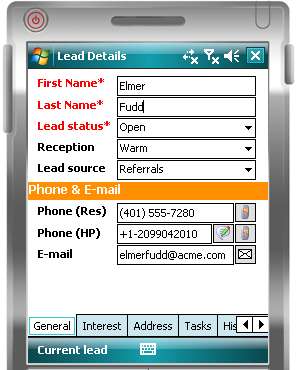
You might be used to the idea that phone numbers, street addresses, and e-mail addresses are related and should all go together under a single Contact Details tab. Thinking objectively though, the salesperson would likely spend more time trying to follow up on a lead making phone calls rather than holding face to face meetings at the lead's address. In this case, it makes for a better design to have the phone number and not the address on the first screen.
When we build this application later on in the book, you will encounter other similar examples and learn how you can minimize the need to switch between tabs by placing the most commonly used fields in a single screen.
We will also extend the idea of objective design to the toolbars and menus in the application, covering best practices and how efficient use of these controls can help reduce on-screen clutter.
You may have also noticed from the previous screenshots that we have placed various icons next to the phone number fields. They allow the user to initiate a phone call or send an SMS directly using the number in the adjacent text box. This control, called the PhoneNumber control (shown in the following screenshot), is one of the various Usercontrols that we will build and reuse throughout this application.
You will also learn how to implement a simple checklist such as the Interested product(s) checklist shown in the succeeding screenshot using the .NET Compact Framework's Listview control.
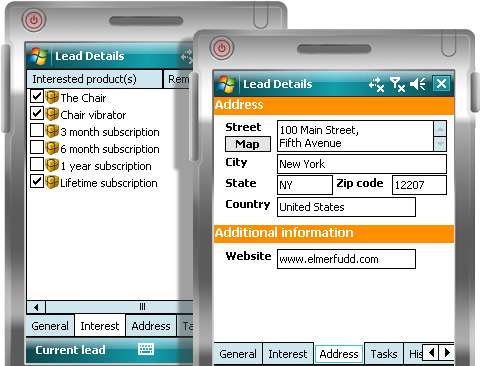
To make things interesting, we will also feature a dynamic product list that can change any time at the remote server end. We will explore how a sync in the opposite direction (from server to mobile device) can be used to update global lists like this in your application.
As this is the first section dealing with data retrieval and manipulation, we will also get a first-hand look at the ADO.NET libraries and how we can make full use of the library to execute SQL queries against the local database to retrieve and manipulate sales force data.
We will cover data access and ADO.NET in full detail when we build a generic data layer in Chapter 2 ,Building the Data Tier.
Transferring data between one mobile device and another is a common requirement in most enterprise scenarios and our sales force application is no exception. At any point in time, a salesperson may decide to hand over a lead to another colleague, possibly because he or she is not interested in following up on that lead.
Passing the lead to another person means that the receiving party needs to have the lead details and all other relevant data transferred to his mobile device. There are a few different approaches to data transfer, which we will cover in detail when the time comes, but for this application we will concentrate on using both Infrared and Bluetooth technology to transfer a lead record (in compressed XML format) directly from one device to another.
One of the reasons for building a task management module in this application is to allow the salesperson to manage tasks that are lead and opportunity specific. We will choose to implement the task listing using the .NET Compact Framework's DataGrid control due to its rich set of data formatting and data binding capabilities.
You will also learn the basics of using the DataGrid control in this section and how to get around its limitations. We will also cover the following subtopics:
- How to data bind an ADO.NET data source to the DataGrid control
- How to implement data paging at the SQL level
- How to create columns with multiple sorting
- How to handle data and cell formatting in the DataGrid control
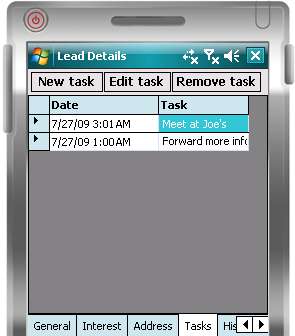
Being able to search within the content of a file and entire databases via an incredibly simple UI comprising a text box and a button is indeed very attractive to any mobile user.
We will build a similar search engine for the sales force application. It will be capable of searching within file content, file names, and database records all at one go.

Microsoft SQL Server Compact and Oracle Lite needs to operate with a small footprint and, unfortunately, does not provide any full-text search feature. We will take it upon ourselves to create a simplified version of the full-text search service of our own. You will learn how to do the following from this exercise:
- How to index the contents of a file for full-text search
- How to handle wildcard and binary searches (the ability to combine multiple search phrases with AND and OR conditions)
- How to create column indices in Microsoft SQL Server Compact and Oracle Lite to improve the performance of full-text search queries
The following screenshot shows what the search results listing will finally look like in your application:
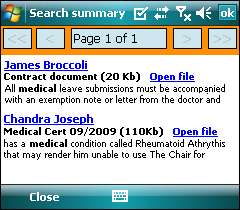
The mobile device is usually packed with useful hardware and operating system features like telephony, GPS, SMS, and Bluetooth, just to name a few. You can use the libraries in the .NET Compact Framework and the open source Smart Device Framework to access a large range of such functionality from your application.
Looking at an example of how this can work with your sales force application, consider phone number displays in your application. As you saw earlier, you will be creating a reusable PhoneNumber usercontrol that allows users to easily place a phone call or send an SMS message.
You will learn how you can call the Windows Mobile classes in the .NET Compact Framework libraries to achieve this. Most of what follows in this section refers to application features discussed earlier.
We will in fact extend this functionality further using the .NET Compact Framework Message Intercept classes to detect incoming phone calls and SMS. You will see how you can use these events to automatically generate historical log entries for every lead. This allows the salesperson to see a comprehensive history of all correspondence with a particular lead.
If you recall, we had to implement a lead and opportunity-specific task list in this application. What is also unique about this task list is that a copy of the tasks will be automatically pushed to the Windows Mobile Calendar. This allows you to tap into the reminder services in Windows Mobile to remind the user of an impending task. You will learn how to integrate with the Windows Mobile Calendar and Contacts services using the .NET Compact Framework libraries to achieve this functionality.
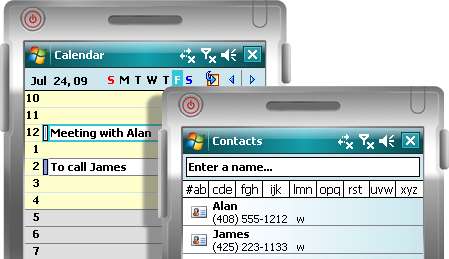
The benefits are twofold. In addition to not having to reinvent the wheel, this sort of integration opens up a host of functionality behind the scenes. For instance, by placing a copy of the lead- and opportunity-specific tasks in the Windows Mobile Calendar, the user will be able to eventually sync them to Microsoft Outlook on his desktop PC via ActiveSync. This feature is immediately available to your users without having to write any additional line of code!
We will also explore how we can transfer the lead details from one device to another directly using both the device's Bluetooth and IrDA (Infrared) capabilities. You will learn how you can efficiently package and compress XML-based data for transmission across these channels.
When new buyers sign up for a subscription to the game, Tomorrow Inc. needs their signature for record purposes. We can implement signature-capturing functionality using the Smart Device Framework's signature control. The signature will be captured as an image and saved together with the customer record in the database.
Note
In Chapters 3 and 6, we will cover more ground on file attachments and how they can be alternatively stored outside the database in the local filesystem. You will also learn of the different options available to the developer to sync files to a remote server.
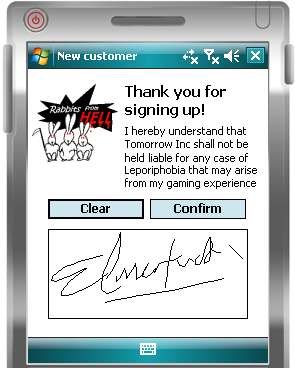
Data synchronization for the sales force application is a mix of bidirectional (between mobile device and server) and unidirectional synchronization (mobile device to server only). The synchronization process is closely tied to the database systems that we are deploying for the application. For instance, Oracle Lite uses mSync technology while Microsoft SQL Server Compact uses the Microsoft Sync Framework.
In Chapter 6, Data Synchronization, you will learn how to set up a mobile device and a server for data sync on these two databases. We will also go through the various approaches available to handle data concurrency and integrity during the sync process.
As part of Tomorrow Inc.'s requirements, we will ensure that our sales force application can support both the Oracle Lite 10g and Microsoft SQL Server Compact mobile databases. These two databases differ considerably in terms of their data types, SQL syntax, and synchronization processes.
As we've covered earlier on in this chapter, one of the biggest disadvantages of a thick client is the deployment process. Any subsequent updates to the application need to be redeployed to all devices.
We will mitigate this drawback by building and integrating a network-aware Auto Update service into our sales force application. You will learn how to create a service that can periodically check and download the latest updates from a remote site on its own without the need to cradle the device.
